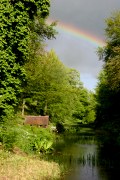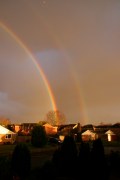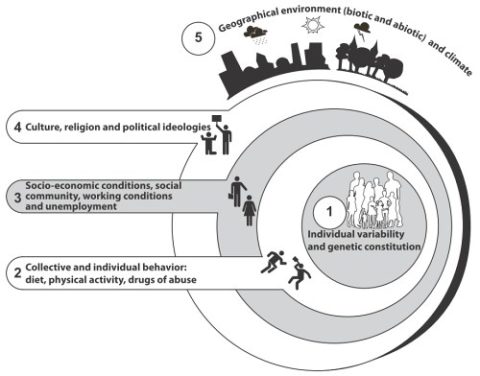Edible cat litter for drug delivery – Having published a bog about bulldogs and cats, seems quite apt that I was also writing recently about kitty litter the main component of which is the absorbant mineral sepiolite. Sepiolite has been known since Roman times when it was used to filter and purify wine, today it's commonly found in cat litter trays. It absorbs huge amounts of liquid as it is so porous although a detailed understanding was missing. Now, an X-ray study could help explain why and perhaps lead to more technological applications, such as the development of food binders and drug-delivery agents.
Month: July 2011
10 things you maybe know about rainbows
 I am currently reading the most excellent “The Sun’s Heartbeat” by astronomy writer Bob Berman. It’s the kind of book I’d love to have written myself, informative, entertaining, engaging, and witty. In it, Berman explains the solar things you may always have wondered about from total eclipses (far more astounding than any partial) and sun spots to the inner sun and the secrets of rainbows. Rainbows you will remember are formed by the refraction of sunlight through water droplets in the sky, what’s more they don’t exist…without you. Every rainbow that ever there was there because someone glanced up and saw it. But, rainbows are even more strange and weird than that cynical glance might suggest. Here are Berman’s 10 things you probably didn’t know about rainbows:
I am currently reading the most excellent “The Sun’s Heartbeat” by astronomy writer Bob Berman. It’s the kind of book I’d love to have written myself, informative, entertaining, engaging, and witty. In it, Berman explains the solar things you may always have wondered about from total eclipses (far more astounding than any partial) and sun spots to the inner sun and the secrets of rainbows. Rainbows you will remember are formed by the refraction of sunlight through water droplets in the sky, what’s more they don’t exist…without you. Every rainbow that ever there was there because someone glanced up and saw it. But, rainbows are even more strange and weird than that cynical glance might suggest. Here are Berman’s 10 things you probably didn’t know about rainbows:
 1 Rainbows are seasonal, being observed late on summer afternoons and extremely rarely in winter, although they do sometimes occur all year round.
1 Rainbows are seasonal, being observed late on summer afternoons and extremely rarely in winter, although they do sometimes occur all year round.
2 You will never see a rainbow if the sun is more than half way up the sky, so you won’t catch sight of one between 9am and 4pm in early summer
3 If the sun is low, the rainbow will be brighter and the colours deeper
4 The sky above a rainbow is much darker than the sky within its arc
5 The top of a rainbow can never be higher than 42 degrees from ground level, such high rainbows seen at sunrise or sunset lack depth in the blue part
6 The ends of a rainbow stop at the ground only because that’s where the rain stops. A rainbow at a waterfall can form a full circle 82 degrees in extent
7 Double rainbows are not that rare. The second bow appears 9 degrees outside the main bow and the colours are reversed. A third bow within the first is never formed but you might see alternating green and pink fringes (non-spectral colours) known as supernmumerary arcs
8 The gap between a primary and secondary rainbow will be darker than the rest of the sky. This region is known as Alexander’s dark band, named for Alexander of Aphrodisias
9 Rainbows are like vampires, they have no reflection and cast no shadow. If you look at a rainbow in a mirror, it’s a different rainbow
10 Every rainbow is an arc, part of a circle and at the centre of the circle is no pot of gold, but something quite shocking. Think about it. The sun is directly behind you, the rainbow lies on an arc parallel to the base of a cone the apex of which is the point at which you stand. So, what’s at the centre of a rainbow? The shadow of your head, of course!
The Kindle version of Bob’s book can be found here: The Sun’s Heartbeat: And Other Stories from the Life of the Star That Powers Our Planet
New nuclear power stations
New nuclear power stations – The UK government is/has approved the building of 8 nuclear power stations in the UK at Hartlepool; Sellafield, Cumbria; Heysham, Lancashire; Wylfa, Isle of Anglesey; Sizewell, Suffolk; Bradwell-on-Sea, Essex; Oldbury, Gloucestershire and Hinkley Point in Somerset. Presumably, the'll produce a lot of gigawatts without contributing directly to CO2 emissions. So…why are we also still messing around with wind, wave and solar? Will the total additional capacity of those 8 nuclear generators (even when older stations close) far outstrip all demand without our having to pepper the countryside with windfarms and frighten the fish? Just curious. I've not done the sums, but I also wonder how we'd cope on cloudy, windless days when the tide is out…thoughts?
More pretty, ugly people
On Monday I posted a Youtube clip revealing a weird perception phenomenon in which even the prettiest girl seems to appear, fleetingly, as if she were an ogre or a troll. Take a look at the ugly pretty girl phenomenon here. I’m never satisfied to simply echo what others have said, so contacted co-discoverer of the effect Jason Tangen and asked him about whether the effect works for males and females and whether or not it might somehow be linked to the origin of monster myths and alien imagery…
“Indeed, the effect works for male and female faces,” he told Sciencebase. Indeed, apparently it is even more weird: “It seems to be a low level perceptual phenomenon, and I doubt it’s unique to faces,” he added. The monstrous faces idea had also occurred to Tangen and his colleagues. “We’ve also considered the possibility that this sort of effect may be related to the origin of mythical stories,” he says, and pointed me to another paper in the Journal Perception by Giovanni Caputo of the University of Urbino in Italy that might lend additional support along with his study to such a hypothesis. In that paper: “Strange-face-in-the-mirror illusion”, Caputo describes an illusion that happens when you catch site of your own reflection in a dimly lit room.
Caputo tested numerous volunteers who reported seeing huge deformations of their own faces (66% of 50 participants), seeing a parent’s face with traits changed (18%; 8% were still alive and 10% were deceased), an unknown person (28%), an old person’s face, a child, or a portrait of an ancestor (28%), an animal face such as that of a cat, pig, or lion (18%), a fantastical or monstrous face (48%).
There is definitely something strange going on. These are not actual apparitions, they’re distortions of perception akin to that experienced by those of you watching the ugly-pretty video. I will report back as new clues emerge…
![]() Caputo, G. (2010). Strange-face-in-the-mirror illusion Perception, 39 (7), 1007-1008 DOI: 10.1068/p6466
Caputo, G. (2010). Strange-face-in-the-mirror illusion Perception, 39 (7), 1007-1008 DOI: 10.1068/p6466
Ugly, pretty girls
This is just plain odd. An accidental discovery. But, why does it happen? Beauty is in the eye of the beholder, but what if something more subtle is occurring?
The phenomenon is known as “flashed face distortion effect” and is described in a research paper thus:
“We describe a novel face distortion effect resulting from the fast-paced presentation of eye-aligned faces. When cycling through the faces on a computer screen, each face seems to become a caricature of itself and some faces appear highly deformed, even grotesque. The degree of distortion is greatest for faces that deviate from the others in the set on a particular dimension (eg if a person has a large forehead, it looks particularly large). This new method of image presentation, based on alignment and speed, could provide a useful tool for investigating contrastive distortion effects and face adaptation.”
I wonder whether it works for people who have not seen caracatures or grotesques of any kind, is it an evolutionary adaption for spotting people with whom your body would prefer you not to produce offspring?
![]() Tangen, J. M., Murphy, S.,, & Thompson, M. B. (2011). Flashed face distortion effect: Grotesque faces from relative spaces Perception : 10.1068/p6968
Tangen, J. M., Murphy, S.,, & Thompson, M. B. (2011). Flashed face distortion effect: Grotesque faces from relative spaces Perception : 10.1068/p6968
Related articles
Red Bull Formula 1 Car Manual
 Red Bull Formula 1 Car Manual – This book, an advance copy of which just pulled into the pits at Sciencebase Central, describes itself as “An insight into the technology, engineering, maintenance and operation of Red Bull racing. It’s the Haynes manual for the F1 car, the owner’s workshop manual, in the style of the classic Haynes manuals generations of British drivers have turned to when they wanted to change their spark plugs or adjust their tappets in pre-computerised driving days.
Red Bull Formula 1 Car Manual – This book, an advance copy of which just pulled into the pits at Sciencebase Central, describes itself as “An insight into the technology, engineering, maintenance and operation of Red Bull racing. It’s the Haynes manual for the F1 car, the owner’s workshop manual, in the style of the classic Haynes manuals generations of British drivers have turned to when they wanted to change their spark plugs or adjust their tappets in pre-computerised driving days.
After the closest-fought season in F1 history, Sebastian Vettel became the youngest-ever World Champion. His car, the Red Bull RB6, the work of a team led by legendary F1 designer Adrian Newey, was the envy of the paddock, proving to be consistently faster than its rivals over the season. In this fascinating book, the Red Bull RB6 receives the Haynes Manual treatment, providing an unprecedented insight into the design, technology and engineering of an F1 car as well as the inner workings of Red Bull Racing. Obviously, more tech than sci, but a great summer read for F1 fans out there.
Related articles
- Amazing Formula 1 Light Paintings (techeblog.com)
- Alonso beats Red Bull drivers for British GP (rt.com)
- Winning formula (bbc.co.uk)
Blame the environment for your bad habits
 Live fast, die young. You’re a long time gone. Sleep when you’re dead. The hedonists mantras. Lifestyle choices whether in terms of food consumption, alcohol and drugs or sexual activity are down to the individual. Nannying by governments, who have their own mantras: Smoking Kills, Know your limits, Get your five-a-day, Use protection, etc, all costs money, is apparently ignored by most people, and probably has little effect on those lifestyle choices.
Live fast, die young. You’re a long time gone. Sleep when you’re dead. The hedonists mantras. Lifestyle choices whether in terms of food consumption, alcohol and drugs or sexual activity are down to the individual. Nannying by governments, who have their own mantras: Smoking Kills, Know your limits, Get your five-a-day, Use protection, etc, all costs money, is apparently ignored by most people, and probably has little effect on those lifestyle choices.
But, some researchers believe that the concept of freewill when it comes to smoking, drinking, poor eating habits and other health risks is not entirely independent of external forces. Claudio Ricciardi of the Department of Environment and Primary Prevention, at the Italian National Institute of Health, in Rome, goes so far as to say that these lifestyle choices are in fact “environmentally induced” and for that reason involve much more complex considerations of social responsibility and ethics than you might at first imagine.
Writing in IJEH (reference below), Ricciardi, a toxicologist by training and a bioethicist by practice, suggests that personal choices are defined by the culture around us, by the political mores, and local environmental conditions. Obvious perhaps, but given that many cultures emphasise the notion of personal freedoms and the individual’s right to choose how they live their life, one might assume that we are entirely free. He argues that the perception of specific risks varies from society to society and among cliques within those societies. Some groups are wont to ignore the risks of extreme sun exposure or heavy smoking while others will frown on such activities while gorging their prandial predilections, for instance.

Economics, politics and the law play an important role. If you’re priced out of a particular market you are unlikely to indulge so frequently in your baddest of habits while prohibition of your treat of choice might prevent you from ever partaking. Hobbies and activities, job (or lack thereof), economic conditions and educational level together with religious and political conditions, all contribute to lifestyle choices good or bad. Then there are your genes to consider…
“All too often,” says Ricciardi, “we witness, without being able to intervene, the growth of a ‘mean attitude’ which claims that smokers, obese and alcoholics should be punished, for their unhealthy lifestyles, with healthcare provided less urgently than that accorded to others. Their behaviours, considered antisocial, represent an added cost to the state and therefore should be punished rather than cured. No one asks, declares or explains the reasons for these unhealthy behaviours and lifestyles.”
I asked Ricciardi for an additional comment regarding my interpretation of his paper. Aside from confirming that I’d got my facts straight regarding what he published, he added that my the emphasis on the notion of “blaming the victims” is what he most wanted to communicate in his paper. “Blaming the victims is actually a very interesting reversal situation,” he told me. One might suppose that it occurs in several other social contexts, such as family and interpersonal relationships and even in historical situations such as The Holocaust. He also pointed out that the issue of genetics is “definitively part of the complexity of the human biological reality,” but he adds that, “its role in developing different lifestyles is limited in comparison to that of the socio-economic components.”
![]() Claudio Ricciardi (2011). Induced harmful lifestyles and healthy choices Int. J. Environ. Health, 5 (3), 262-273
Claudio Ricciardi (2011). Induced harmful lifestyles and healthy choices Int. J. Environ. Health, 5 (3), 262-273
Graphic by Cosimo Marino Curianò
Watch the last Shuttle launch live
UPDATE: The Orbiter made it into orbit, the live stream is now ended. I’ll replace the video embed with a Youtube clip to re-run the launch…
A group of us skipped a high school physical education class to watch the very first shuttle launch way back when. At the time, we assumed they’d be launching a couple of Orbiters every week thereafter (that was the plan, apparently). But, that wasn’t to be. Now, you can watch the last ever Shuttle launch, live with Sciencebase courtesy of NASA’s Ustream, assuming the weather holds…
Periodic Table of QR codes
 Periodic Table of QR codes – QR codes are those little black and white boxes that look like a messed up barcode, which is essentially what they are, 2D barcodes. They’re becoming almost ubiquitous. Every event you attend, every restaurant you pass, almost every site you visit seems to have a QR code. You can embed all kinds of information and even add logos without breaking their functionality. But, best of all you can use them to visit a website with your smartphone by simply aiming its camera at the QR (either on a screen or printed in a shop window, for instance) and up pops the appropriate page.
Periodic Table of QR codes – QR codes are those little black and white boxes that look like a messed up barcode, which is essentially what they are, 2D barcodes. They’re becoming almost ubiquitous. Every event you attend, every restaurant you pass, almost every site you visit seems to have a QR code. You can embed all kinds of information and even add logos without breaking their functionality. But, best of all you can use them to visit a website with your smartphone by simply aiming its camera at the QR (either on a screen or printed in a shop window, for instance) and up pops the appropriate page.
I’ve added a QR to Sciencebase and re-enabled the QR for Sciencetext. You can thank Brady Haran of PToV fame for inspiring me to do so. He emailed me earlier today to alert me to the Periodic Table of QR Codes. Each QR is basically a link to a video in the PToV from Nottingham Uni’s chemistry department. Point and shoot and up pops the appropriate Youtube clip. Simple. Brilliant. Fun. Ubergeek. Chemical.
Of course, you have to know which element’s QR code you’re pointing your camera at if you want to bring up a specific video, but there’s half the fun and a boon for testing chemistry students. Print off the high-resolution version, post it on the lab wall and let the students give it a try. If you’re using it on screen it works best if you open the original uploaded graphic from Brady.
Bleached in space
Bleached in space – Great news for cosmic hairdressers. ESO has discovered hydrogen peroxide in space. If you look at the photo, there’s a little red ring, that’s the stuff right there. On Earth, hydrogen peroxide plays a key role in the chemistry of water and ozone in our planet’s atmosphere, but is familiar in solution form for its use as hair bleach and as a disinfectant. Oh, and in high school science labs when you add it to slices of liver to make them froth with enzymic activity.
Seriously though, detecting molecules of hydrogen peroxide in the space between the stars could offer clues about the chemical link between two molecules critical for life: water and oxygen. The discovery adds this important chemical to the growing list of small molecules, both inorganic and organic, that have been detected in space including carbon dioxide, water, methane and more complicated organics.